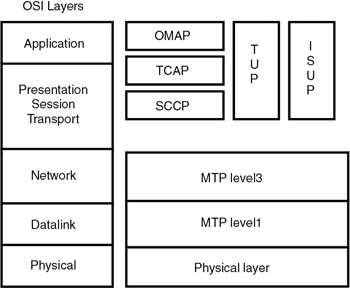26.5 SS7 PROTOCOL LAYERS
|
| < Day Day Up > |
|
26.5 SS7 PROTOCOL LAYERS
The protocols in SS7 follow layered architecture. The protocol layers are shown in Figure 26.4. The functions of each layer follow.

Figure 26.4: SS7 Protocol layers.
Physical layer: The physical layer defines the physical and electrical characteristics of the link. The links carry raw signaling data at 56 or 64kbps.
Message transfer part level 2 (MTP level 2): This layer provides link layer functionality to ensure that the messages are reliably exchanged. The functions are error checking, flow control, and sequence checking.
Message transfer part level 3 (MTP level 3): This layer provides network layer functionality to ensure delivery even if signaling points are not directly connected. The functions include node addressing, routing, alternate routing, and congestion control.
The bottom three layers in the SS7 protocol architecture are: (a) physical layer that supports 56 or 64kbps data rate; (b) message transfer part level 2, which provides error checking, flow control, and sequence checking; and (c) message transfer part level 3, which provides addressing, routing, and congestion control.
MTP level 2 and level 3 together are known as MTP.
Signaling connection control part (SCCP): SCCP provides capability to address applications within a signaling point. MTP can only receive and deliver messages from a node, but it does not deal with software applications within a node. MTP messages handle call setup and network management messages. Other messages are used by separate applications (referred to as subsystems) within the node. Examples are 800 call processing, calling card processing, advanced intelligent network (AIN), repeat dialing, and call return services. SCCP allows these subsystems to be addressed explicitly.
SCCP's second function is to perform incremental routing using global title translation (GTT) capability. Because it is practically impossible for an originating signaling point to know all the possible destinations to route a message, GTT is introduced. A switch can originate a query and address it to its STP along with a request for GTT. For example, consider the case of a calling card query. It has to be routed to a particular SCP that contains the calling card data. It is not possible for each STP to know this SCP, so the originating STP will route the message to a specific STP, which in turn routes the message to the destination STP/SCP.
Telephone user part (TUP) and ISDN user part (ISUP): TUP and ISUP define the messages and protocols to establish and disconnect voice and data calls over public switched networks such as PSTN/ISDN and to manage the trunks.
| Note | SS7 is now being used in the PSTN as well. To establish and disconnect voice and data calls over the PSTN and ISDN, telephone user part and ISDN user part protocols are defined. |
Transactions capabilities application part (TCAP): TCAP defines messages and protocols used to communicate between applications such as 800 services, calling card services in the nodes, and the switches. Since TCAP messages must be delivered to individual applications with the node they address, these messages use SCCP for transport.
| Note | Value-added services such as toll-free number service and calling card service are handled by the transaction capabilities application part (TCAP) protocols. |
Operations, maintenance, and administration part (OMAP): OMAP defines messages and protocols to administer SS7 networks. The functions include validation of route tables and diagnosis of links. OMAP is an application that uses the TCAP and SCCP services.
|
| < Day Day Up > |
|
EAN: 2147483647
Pages: 313
- Challenging the Unpredictable: Changeable Order Management Systems
- The Second Wave ERP Market: An Australian Viewpoint
- Enterprise Application Integration: New Solutions for a Solved Problem or a Challenging Research Field?
- The Effects of an Enterprise Resource Planning System (ERP) Implementation on Job Characteristics – A Study using the Hackman and Oldham Job Characteristics Model
- A Hybrid Clustering Technique to Improve Patient Data Quality